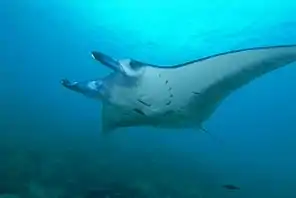Andrea Marshall
Andrea Marshall is a marine biologist known for her wildlife conservation and research on ocean life, specializing in manta rays. She is one of the founders of the Marine Megafauna Foundation[1] and was the subject of the Natural World documentary Andrea: Queen of Mantas.[2] She now works at the Manta Ray & Whale Shark Research Center at Tofo Beach, Mozambique.[3] In 2013, she was named a National Geographic "Emerging Explorer" for her research.[4]
Andrea Marshall | |
|---|---|
.jpg.webp) Marshall in 2012 | |
| Known for | Research into manta rays |
| Scientific career | |
| Fields | Marine biology |
| Institutions | Manta Ray & Whale Shark Research Center at Tofo Beach, Mozambique |
| Thesis | (2008) |
Early life and education
Andrea Marshall's interest for marine life started around age twelve when she first learned to dive. During that age, she gained a love for shark conservation. While in Mozambique on a family vacation, young Andrea stumbled upon a mass of manta rays.[5] That is where her love for these sea animals began.
In 2008, Andrea Marshall earned her PhD studying the manta ray species at the University of Queensland in Australia. She was the first student to get a degree for manta ray ecology.[5]
Career
Dr. Marshall completed her thesis in 2008, and after receiving her PhD, she devoted the rest of her life to the giant “sea birds.”[1] She now lives in southern Mozambique as an activist for manta ray protection. There she helps organize scientific strategies to protect the sea animals that are living right in their backyards.[6]
Later in 2009, she had revealed a new species of manta ray.[1] Currently, there is one species called the Manta Birostris that is considered to be the “Giant Manta” (Warner).[7] These rays, that can grow up to 23 feet long, still possess a smaller portion of their once large stinger on the end of their tails. These stingers cause no harm to humans and are now worthless. The second species that was discovered by Dr. Marshall is called the Manta Alfredi. This second species stays closer to the reefs and is much smaller in size. This new species is one of the largest fish discoveries that scientists have seen in over 45 years. Andrea has also found a third species but has spent the last ten years organizing and continuing to find more information about the horned “devil-looking” fish. Nothing has been published yet about this third species.[1]

To find all this new information, she has used expensive diving technology and photography devices.[1] She developed Manta Matcher, an online citizen science database for identifying individual manta rays from their unique markings.[8]
As a global advocate for her underwater companions, Andrea has investigated all her energy in studying their ecology, habitat domains, and social orientation.[1] She has also studied the animals’ migration patterns finding out that in just 60 days, they migrate more than 650 miles. The journey that Dr. Marshall takes with the manta rays has been recognized as the longest fish migration in the Indian Ocean.[2]
Andrea has studied manta rays all over the globe. Her work has been credited in several magazines and online articles. In 2013, her BBC documentary was made available to the public eye. In this documentary she talks about why she is so attached to these mysterious fish and how she advocates for the terrible threats they face.[2] Some threats include habitat destruction, over-fishing, and reckless boat incidents.[9]
Family
Andrea is married and has a young daughter. All three spend months traveling from one manta ray coast to another.[1] Dr. Marshall must stay close to the local neighborhoods as well as the manta rays to be able to do her job well. Andrea and her family are currently living in Vilanculos, Mozambique.[9]
Foundations & honors
Andrea is the CEO and one of the main founders of the Marine Megafauna Foundation (MMF). This foundation strives to protect all ocean giants from the dangers that they are facing.[1]
National Geographic also endowed the 2013 Emerging Explorer honor to Andrea. This award was given to 17 individuals who National Geographic believes are notable explorers.[10]
References
- Society, National Geographic. "Learn more about Andrea Denise Marshall". www.nationalgeographic.org. Retrieved 2019-10-23.
- "Manta ray's secret life revealed". 2009-11-09. Retrieved 2019-11-03.
- Do Fish Sleep?
- "Announcing the 2013 Class of Emerging Explorers". National Geographic Society Newsroom. 2013-05-15. Retrieved 2019-10-30.
- Macdonald, Jessica (2015-02-06). "Famous Female Divers: Andrea Marshall". Scuba Diver Life. Retrieved 2019-10-23.
- Queen of Mantas
- "12 amazing facts about manta rays you might not know". Discover Wildlife. Retrieved 2019-10-30.
- Town, Christopher; Marshall, Andrea; Sethasathien, Nutthaporn (July 2013). "Manta Matcher: automated photographic identification of manta rays using keypoint features". Ecology and Evolution. 3 (7): 1902–1914. doi:10.1002/ece3.587. ISSN 2045-7758. PMC 3728933. PMID 23919138.
- "Andrea Marshall publishes discovery of second species of manta ray". Save Our Seas Foundation. 2009-12-03. Retrieved 2019-10-30.
- "Announcing the 2013 Class of Emerging Explorers". National Geographic Society Newsroom. 2013-05-15. Retrieved 2019-10-30.